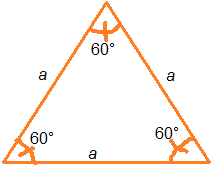The Symmetry is an important geometrical concept, commonly exhibited in nature and is used almost in every field of activity.
A figure has a line symmetry, if there is a line about which the figure may be folded so that the two parts of the figure will coincide.
As we know the polygon is a closed figure made of several line segments. The polygon made up of the least number of line segments is the triangle.
A polygon is said to be regular if all its sides are of equal length and all its angles are of equal measure. Thus, an equilateral triangle is a regular polygon of three sides.
An equilateral triangle is regular because each of its sides has same length and each of its angles measures 60°

A square is also regular because all its sides are of equal length and each of its angles is a right angle (i.e., 90°).
Rotation, like movement of the hands of a clock, is called a clockwise rotation; otherwise it is said to be anticlockwise.
When an object rotates, its shape and size do not change. The rotation turns an object about a fixed point. This fixed point is the centre of rotation.
The angle of turning during rotation is called the angle of rotation. A full turn, you know, means a rotation of 360°.
A half-turn means rotation by 180°; a quarter-turn is rotation by 90°.
The circle is the most perfect symmetrical figure, because it can be rotated around its centre through any angle and at the same time it has unlimited number of lines of symmetry.
